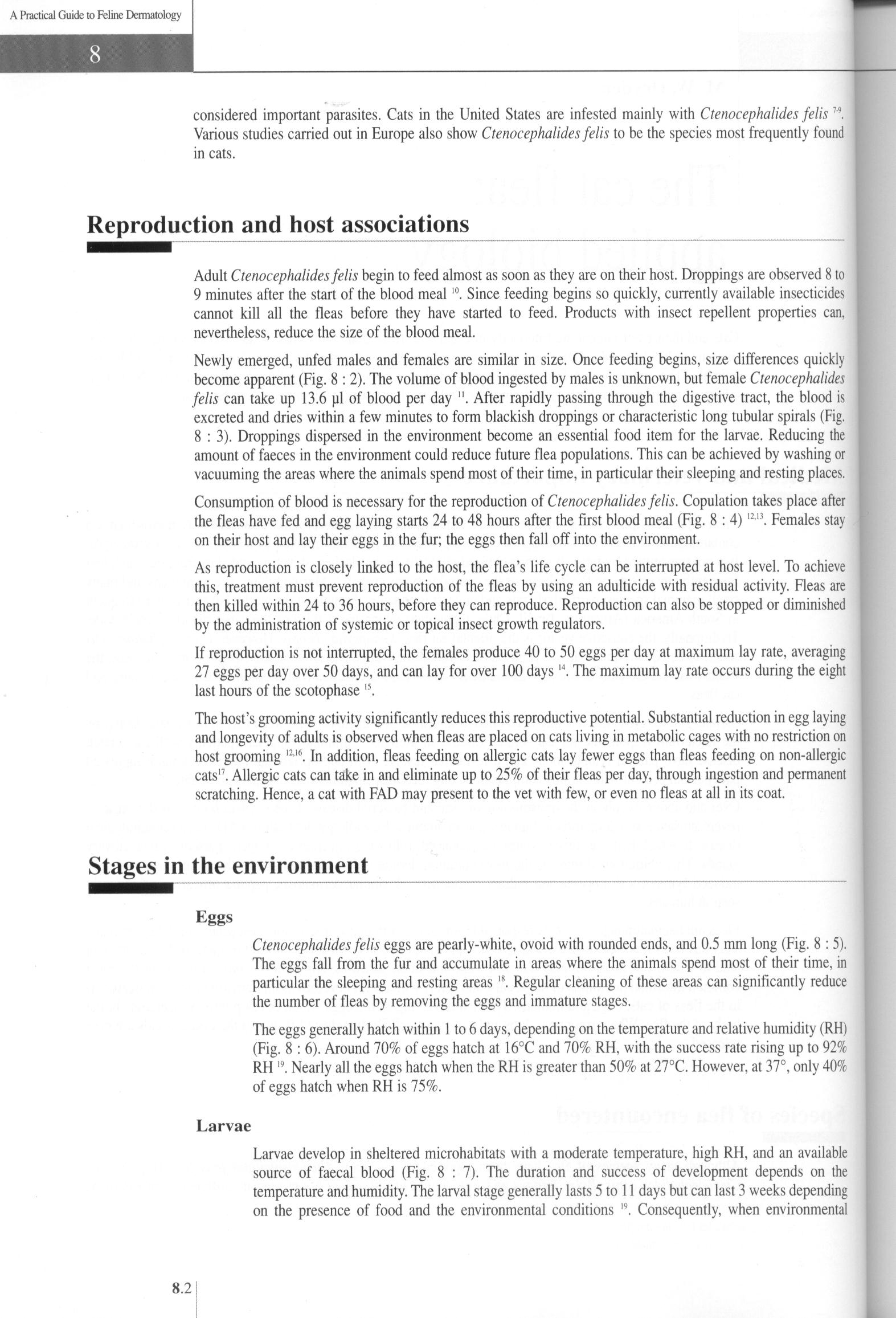82 (128)

8
A Practical Guide to Feline Dermatology
considered important parasites. Cats in the United States are infested mainly with Ctenocephalides felis 1'\ Various studies carried out in Europę also show Ctenocephalides felis to be the species most freąuently found in cats.
Reproduction and host associations
Adult Ctenocephalides felis begin to feed almost as soon as they are on their host. Droppings are observed 8 to 9 minutes after the start of the blood meall0. Since feeding begins so ąuickly, currently available insecticides cannot kill all the fleas before they have started to feed. Products with insect repellent properties can, nevertheless, reduce the size of the blood meal.
Newly emerged, unfed males and females are similar in size. Once feeding begins, size differences ąuickly become apparent (Fig. 8 : 2). The volume of blood ingested by males is unknown, but female Ctenocephalides felis can take up 13.6 pl of blood per day ". After rapidly passing through the digestive tract, the blood is excreted and dries within a few minutes to form blackish droppings or characteristic long tubular spirals (Fig. 8 : 3). Droppings dispersed in the environment become an essential food item for the larne. Reducing the amount of faeces in the environment could reduce futurę flea populations. This can be achieved by washing or vacuuming the areas where the animals spend most of their time, in particular their sleeping and resting places.
Consumption of blood is necessary for the reproduction of Ctenocephalides felis. Copulation takes place after the fleas have fed and egg laying starts 24 to 48 hours after the first blood meal (Fig. 8 : 4)1213. Females stay on their host and lay their eggs in the fur; the eggs then fali off into the environment.
As reproduction is closely linked to the host, the flea’s life cycle can be interrupted at host level. To achieve this, treatment must prevent reproduction of the fleas by using an adulticide with residual activity. Fleas are then killed within 24 to 36 hours, before they can reproduce. Reproduction can also be stopped or diminished by the administration of systemie or topical insect growth regulators.
If reproduction is not interrupted, the females produce 40 to 50 eggs per day at maximum lay ratę, averaging 27 eggs per day over 50 days, and can lay for over 100 days14. The maximum lay ratę occurs during the eight last hours of the scotophase l5.
The host’s grooming activity significantly reduces this reproductive potential. Substantial reduction in egg laying and longevity of adults is observed when fleas are placed on cats living in metabolic cages with no restriction on host grooming l216. In addition, fleas feeding on allergic cats lay fewer eggs than fleas feeding on non-allergic cats17. Allergic cats can take in and eliminate up to 25% of their fleas per day, through ingestion and permanent scratching. Hence, a cat with FAD may present to the vet with few, or even no fleas at all in its coat.
Stages in the enyironment
Eggs
Ctenocephalides felis eggs are pearly-white, ovoid with rounded ends, and 0.5 mm long (Fig. 8 : 5). The eggs fali from the fur and accumulate in areas where the animals spend most of their time, in particular the sleeping and resting areas '8. Regular cleaning of these areas can significantly reduce the number of fleas by removing the eggs and immature stages.
The eggs generally hatch within 1 to 6 days, depending on the temperaturę and relative humidity (RH) (Fig. 8 : 6). Around 70% of eggs hatch at 16°C and 70% RH, with the success ratę rising up to 92% RH '9. Nearly all the eggs hatch when the RH is greater than 50% at 27°C. However, at 37°, only 40% of eggs hatch when RH is 75%.
Larvae
Larvae develop in sheltered microhabitats with a moderate temperaturę, high RH, and an available source of faecal blood (Fig. 8 : 7). The duration and success of development depends on the temperaturę and humidity. The larnl stage generally lasts 5 to 11 days but can last 3 weeks depending on the presence of food and the environmental conditions 19. Conseąuently, when environmental
Wyszukiwarka
Podobne podstrony:
58 (148) 5 A Practical Guide to Feline Dermatology severity of the illness. High titres are seen wit
65 (127) 6 A Practical Guide to Feline Dermatology Other topical antimicrobial agents, such as chlor
67 (125) 6 A Practical Guide to Feline DermatologyNocardiosisAetiopathogenesis Nocardiosis is a very
69 (119) 6 A Practical Guide to Feline DermatologyDiagnosis The diagnosis is based on lesion distrib
710 (2) 7 A Practical Guide to Feline DermatologyHerpesvirus infections Dermatological manifestation
74 (105) 7 A Practical Guide to Feline Dermatology ulcerated. Lesion distribution is multicentric bu
27 A Practical Guide to Feline Dermatology Perianal glands 1.7 Permethrin 3.12, 3.13 Persian 1.6,2.2
27 A Practical Guide to Feline Dermatology Stemphyllium spp. 5.1,7.8 Stereotypie behaviour 17.1,
272 (16) 27 A Practical Guide to Feline Dermatology Alternaria spp. 5.1,7.8 Aluminium hyroxide 15.6&
274 (18) 27 A Practical Guide to Feline Dermatology Colitis 11.2 Collagen 1.2,2.6,12.1,
278 (17) 27 A Practical Guide to Feline Dermatology I J Histoplasmosis 5.8, 7.8, 25.2 Homer’s syndro
28 (374) 2 A Practical Guide to Feline Dermatology Configuration of lesions Determining the configur
313 (14) A Practical Guide to Feline Dermatology The second phase consists of long-term control of t
31 (328) 3 A Practical Guide to Feline Dermatology Sarcoptic mange Sarcoptes scabiei var canis (Tabl
42 (226) 4 A Practical Guide to Feline Dermatology Increased hydration and subsequent maceration of
44 (228) 4 A Practical Guide to Feline Dermatolog) The term “asymptomatically infected cat” refers
46 (213) 4 A Practical Guide to Feline Dermatology from cats with untreated infections are often pos
48 (209) 4 A Practical Guide to Feline Dermatology Table 4:1: Type of hair invasion, fruiting bodies
510 (5) A Practical Guide to Feline DermatologyCoccidioidomycosisAetiopathogenesis Coccidioidomycosi
więcej podobnych podstron